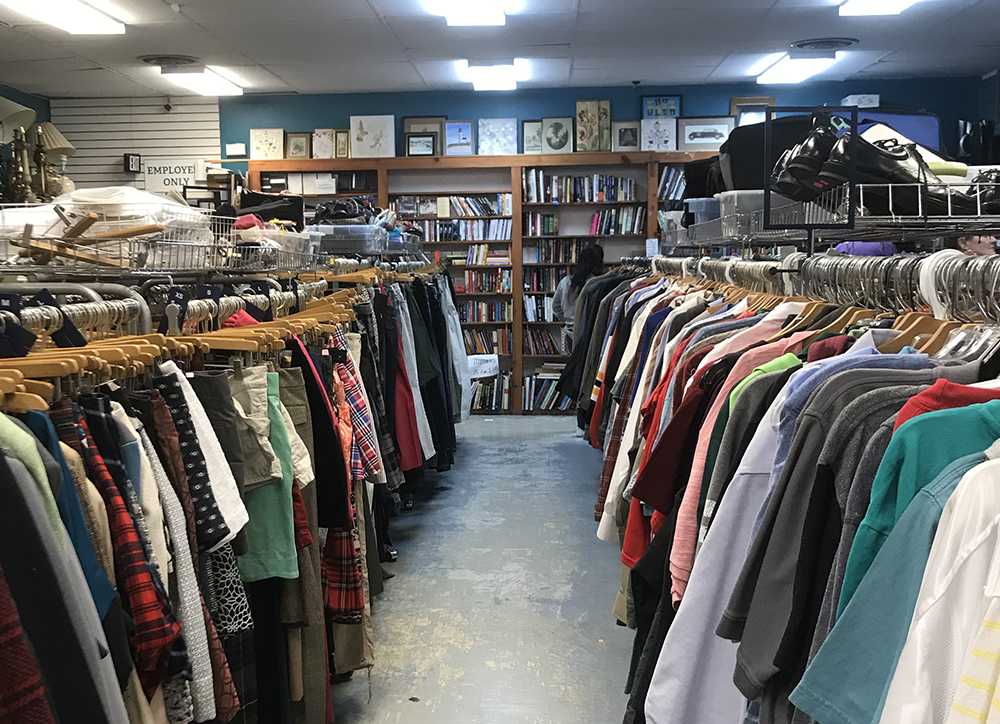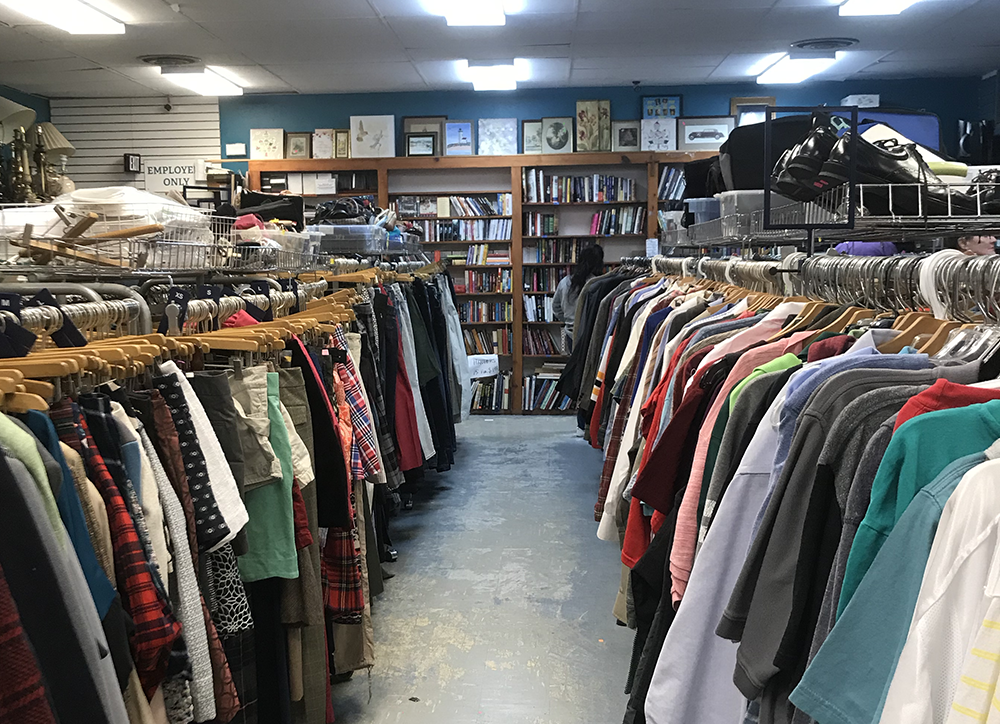Even on Georgetown University’s campus, where designer logos and styles can feature prominently on students’ clothing, shopping for secondhand clothing at thrift stores in the area is an avenue for students to showcase their individual fashion sense while maintaining cost-effectiveness.
From cost to environmentalism to vintage style, students have many different motivations for buying clothing secondhand. Thrifting has expanded the methods by which Georgetown students encounter their newest wardrobe items, even if the distance of the traditional brick-and-mortar locations has moved some of the process to the internet or caused certain students to hesitate to travel out to the suburbs of Washington, D.C.
Navigating Cost
For many college students, budget is a major concern when shopping for clothes. Thrifting provides an opportunity to expand their wardrobes for a fraction of the cost of new clothing, especially from higher-end stores in the greater Georgetown neighborhood.
Popular retailers such as Urban Outfitters and Brandy Melville charge upward of $30 for vintage-inspired clothing that can often be found at thrift stores for significantly cheaper prices.
The popularization of thrifting overlaps with a desire for affordability, as these inventive styles can encourage more people, like Amanda Estevez (COL ’23), to shop for cheaper secondhand clothing rather than opting for pricy brands to make a statement. The process of shopping secondhand can be a way to breathe new life into fashion while staying economically conscious, according to Estevez.
“It’s to reclaim old clothing,” Estevez said in an interview with The Hoya. “It’s to give new life to pieces and to allow people to be inventive with their style on a budget.”
On the other hand, although thrifting may save money, it takes more time than traditional shopping. Students who thrift must be willing to sift through countless piles of used clothing in various sizes, styles and degrees of quality to find a piece they want to wear.
Thrifting in the D.C. area differs depending whether shoppers are looking for more expensive options directly in the District or are willing to travel into the suburbs of Maryland and Virginia to find better deals. Shoppers can find a range of styles, from homey to trendy, in the Goodwills of suburban Virginia and the high-end consignment stores of Georgetown.
One affordable option is Clock Tower Thrift Shop, a store run by Northern Virginia Family Service that sells everything from furniture and toys to clothing and jewelry. Their purpose is not necessarily to be a trendy spot for vintage finds, but rather to offer a public service and strengthen the regional community, according to their website. They donate all proceeds from the project back into programs within Falls Church, Va., where the store is located.
Clock Tower sells brands like Loft and Mossimo but is also stocked to the brim with every knickknack imaginable — the kind of store that could result in hours of treasure hunting.

By contrast, Reddz Trading, located in Georgetown at the intersection of Wisconsin Avenue and P Street, sells preowned clothing but is not a traditional thrift store like Clock Tower. Rather, Reddz is classified as a consignment shop because it sells items on behalf of their owners and receives a percentage of the profit. The store is stocked with higher-end brands like Wildfox and Vince.
Reddz serves as a bridge between the relatively expensive Georgetown neighborhood and the bargain finds at a typical secondhand store, and this reality influences the dynamic of the relationship between the shopper and the clothing, according to Lauren Breslow, Reddz’s assistant store manager.
“We are strictly buy, sell, trade, and it’s special because it’s a win-win situation for the buyer and the seller,” Breslow said in an interview with The Hoya. “The unaffordable becomes the affordable.”
Although Reddz is not technically a thrift store, it has still witnessed the shift in thrifting culture that sees more young people finding value in reselling and purchasing used clothes, according to Breslow. Reddz was not initially built to cater to college students, but the influence of frequent local visitors has led the shop to shift its inventory toward a younger audience, according to Breslow.
“We have been buying in a lot more young stuff, with the goal to get everyone to come in here, including millennials,” Breslow said. “It’s becoming more inclusive.”
Closer to Home
Georgetown students have also turned to online thrifting options because of the challenge of traveling out to suburban thrift shops. Many online marketplaces, such as Depop and thredUP, allow users to buy and sell every category of used clothes. Other consignment websites such as The RealReal and Poshmark specifically offer options for buying and selling previously owned luxury high-fashion and designer goods.
Thrift retailer websites streamline the thrifting process by eliminating the time shoppers spend searching through racks for their size. They neatly organize the available merchandise into categories with pictures and prices. This organizational benefit comes at a financial cost, however, as the sites typically require registration, take a cut of the sales and offer expensive shipping, which can drive up the price of thrifting.
The challenge of thrifting in D.C. has led students to get crafty with their clothing hunts. Gina Kang (SFS ’22) frequently participates in clothing swaps on and off campus, most of which she discovers through Facebook rather than by going to actual thrift stores.
Buying and selling used clothing is a sensible way to go about curating a wardrobe and going against the sweatshops of fast fashion brands like ASOS and H&M, according to Kang.
“For me personally, it’s always just felt like the right option to me, even before I learned about fast fashion,” Kang said in an interview with The Hoya. “I would never think to buy something full price when I could just buy it thrifted. I don’t see why anyone would not go to a thrift store.”
Similarly to Estevez, Kang is motivated to thrift by a desire to keep up with trends and innovation in a cost-effective and sustainable way.
“It’s become a more popular thing to do because, besides the sustainability of it, it allows you to find a unique style,” Kang said in an interview with The Hoya. “I can cycle through different styles without feeling guilty about it.”
An increasing number of student organizations on campus have started thrift exchanges. Uncommon Grounds has hosted pop-up thrift stores on the Leavey Esplanade in recent years and the Georgetown Renewable Energy and Environmental Network and Thirty Seventh GU, a campus fashion and lifestyle blog, have hosted semesterly clothing swaps to encourage reusing and recycling clothing.
The thrifting community appreciates the environmental effect of the enterprise. Along these lines, thrifting has become an easy and fun way to responsibly source clothing that shies away from unethical fast fashion companies, according to Breslow.
“Buying resold clothing is becoming more popular,” Breslow said. “Fast fashion destroys the environment, and people don’t want to be a part of that anymore.”
Challenging Finds
Parallel to the transition that has occurred in traditional brick-and-mortar retail stores with regard to the thrifting demographic, young people themselves have come up with increasingly creative ways to purchase used clothes for a cheaper price while reflecting a sustainable outlook on clothing.
Natalie Regan (COL ’23) thrifted often in her hometown of Chicago, where there are multiple thrift shops within driving distance of her house (Full disclosure: Regan serves as a photo assistant for The Hoya.) At Georgetown, she has gone thrifting at many different locations, including at Buffalo Exchange near Logan Circle and at the now closed Crossroads Trading near U Street.
With many of the secondhand stores in the Georgetown area offering pricy consignment items, Regan has turned to more traditional thrifting options in Northern Virginia. However, these options present their own challenges because of their distance from campus, according to Regan.
“The major issue is that the thrift stores are pretty inaccessible, especially those in Northern Virginia,” Regan explained in an interview with The Hoya.
While the value in thrifting is in the clothes themselves, sometimes finding ways to access these distant thrift stores throughout the D.C.-Maryland-Virginia area can be more expensive than buying other clothes from nearby at face value, according to Regan.
“I ended up paying around two times as much for the transportation as I did for the clothes I bought, and other forms of transportation are not very convenient, either,” Regan said. “These obstacles have discouraged me from thrifting recently.”
Despite the struggles that can be associated with thrifting, the experience can ultimately be incredibly rewarding for students who can maintain a distinct fashion sense without breaking the bank, according to Regan.
“I get clothes that are unique while also saving money, searching through the options and finding a shirt or pair of jeans that I wouldn’t find somewhere else,” Regan said. “That’s the beauty of thrifting.”





















thrift shop in Panama City Beach, FL • Aug 23, 2021 at 2:07 am
No doubt, the post is incredible, and also every time I read your blog I just got fastened with the content of the post. How easily you describe each and every perspective of the topic of the post.
April • Mar 12, 2020 at 4:26 pm
This is great way to source items for apps like ebay and poshmark. I would recommend using a sharing service such as http://www.closetassistantpm.com